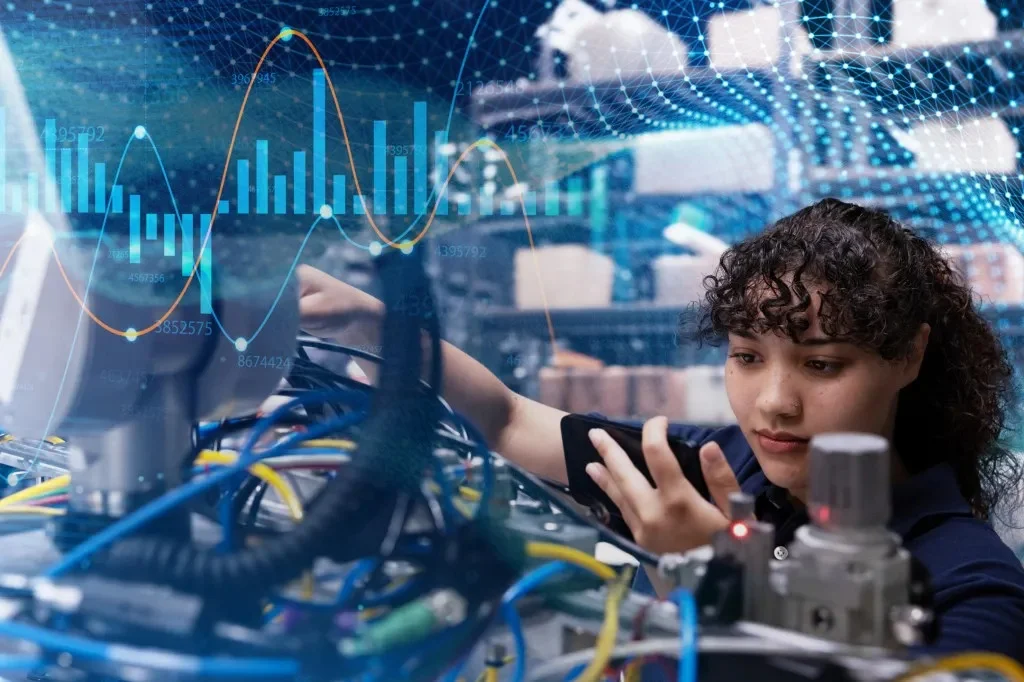By Stephanie Leonida on Control Automation
Siemens and Microsoft have launched their jointly developed "generative AI-powered assistant," Siemens Industrial Copilot, to help workers with PLC programming and machine troubleshooting.
Siemens and Microsoft are building on their existing partnership to push the wider adoption of generative artificial intelligence (AI) in industries worldwide. The duo recently introduced the jointly developed, AI-powered assistant, Siemens Industrial Copilot, and will soon release its virtual collaboration tool, Teamcenter for Microsoft Teams.

With Siemens Industrial Copilot, industrial maintenance teams can collaborate with a “generative AI-powered assistant” to discern machinery or system faults and find potential solutions. Image used courtesy of Siemens
Generative AI in Manufacturing
Generative AI, such as OpenAI, was founded as part of an initiative focused on using artificial intelligence to help support and advance humanity. OpenAI’s small to larger-scale pre-trained natural language models from the GPT series have revolutionized scientific research and industrial operations through natural language text generation, text interpretation, data analysis, and code generation. According to McKinsey Digital, generative AI could increase labor productivity between 0.1 to 0.6% year-on-year through 2040.
In the context of manufacturing, generative AI is being employed to help designers flexibly create 3D-printed parts, speed up prototyping, simulate and evaluate manufacturing processes and workflows, create more cost-effective and energy-efficient products and services, conduct inspections, and see that products comply with quality assurance standards, as well as produce, enhance, and debug code for automated machinery and systems.
Siemens Industrial Copilot
Siemens Industrial Copilot, coined as a “generative AI-powered assistant,” was developed to help engineers write code for industrial machinery, identify issues or bugs, and provide solutions to get operations back on track. Industrial Copilot can communicate with industrial maintenance teams in a chatbot-style fashion to resolve issues and translate code in different programming languages.
Industrial Copilot uses Siemens' open digital business platform, Siemens Xcelerator, to access and collect process simulation and automation data. This data works alongside Microsoft Azure’s OpenAI service to help industrial engineers generate code for automated systems and simulations.

With the integration of AI and ChatGPT, Industrial Copilot can help with programming Siemens control systems and troubleshooting machine issues. Image used courtesy of Siemens
Generating Possibilities
Industrial Copilot can help write PLC programming code for Siemens control systems. This code acts as an intermediary between machines, instructing them to execute particular duties, including the order in which they are to be performed, and then designating the optimum operating conditions. In addition to generating code, Industrial Copilot demonstrates its capabilities by translating code from several programming languages and optimizing it for maximum performance.
Another use case for Industrial Copilot is the troubleshooting of industrial machinery inefficiencies. It can help target the core underlying faults and propose new code to debug existing code. Industrial Copilot mimics the functionality of natural language tools like ChatGPT to provide a platform for communication between itself and industrial maintenance teams. As if chatting with a knowledgeable colleague, maintenance teams can express difficulties, ask for clarification, and discuss proposed adjustments.

Schaeffler was an early adopter of Siemens Industrial Copilot, integrating generative AI in the engineering phase of its operations. Video used courtesy of Siemens
SOURCE: Click to read the full report.